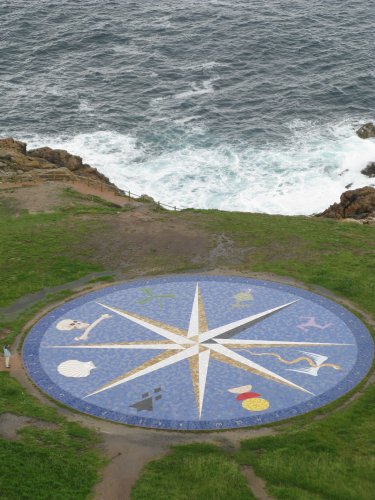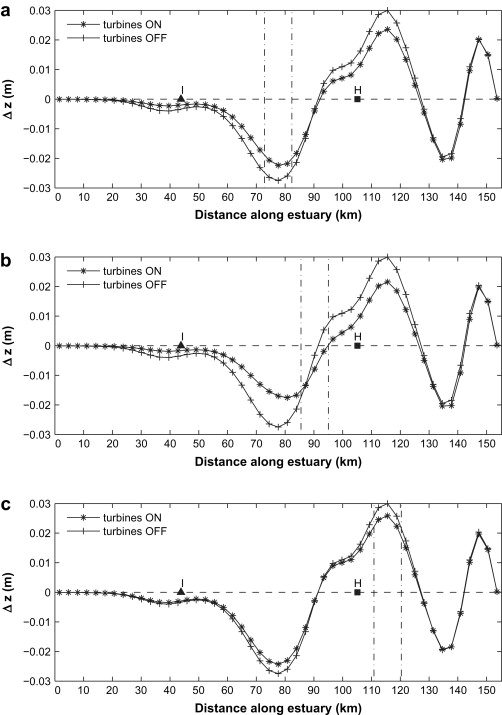
Shelf Sea Modelling Research Group
Marine Renewable Energy

In collaboration with Scott Couch (Edinburgh University) and Alan Davies (Bangor University), I have been determining the environmental impact of exploiting the tidal stream resource. Initially, this has been through modelling changes to the sediment dynamics of a large estuarine system (the Bristol Channel). You can read a summary of this research on NERC Planet Earth Online. We are presently incorporating the impacts of energy extraction by marine renewables into state-of-the-art three-dimensional tidal models (e.g. Neill et al., 2011). This research is funded by the Low Carbon Research Institute (LCRI) in Wales. Most recently, I have begun a collaboration with Gregorio Iglesias (University of Santiago de Compostela), modelling the nearshore impacts of wave energy converters. This collaboration has so far been supported by a Santander Mobility Scholarship (awarded to Simon Neill).
Our work into modelling the environmental impact of marine renewables has received a recent boost in the form of the £40M High Performance Computing (HPC) Wales project. This considerably increases our modelling capability, allowing us to include feedbacks between the evolving bathymetry and the hydrodynamics over long (several decades) timescales.
Our numerical simulations (Neill et al., 2009) demonstrate that a full-scale (250 MW) tidal stream turbine farm placed in a large estuary (the Bristol Channel) could have serious implications on large-scale sediment dynamics, with the effects measurable up to 50 km from the site of energy extraction. However, by strategically locating the farm with reference to the natural tidal asymmetry of the system, this impact can be minimised (see figure below). In (a), the tidal stream farm has been placed in a region of sediment divergence (tidal symmetry), (b) tidal stream farm in region of tidal asymmetry and (c) tidal stream farm in region of sediment convergence (tidal symmetry).

Excellent animations of the principals of operation of tidal stream turbine farms are available from OpenHydro (file size is 21.5MB) and Marine Current Turbines.
Relevant publications:
- Neill, S.P. and Hashemi, M.R. (2013) Wave power variability over the northwest European shelf seas. Applied Energy 106, 31-46.
- Neill, S.P., Jordan, J.R. and Couch, S.J. (2012) Impact of tidal energy converter (TEC) arrays on the dynamics of headland sand banks. Renewable Energy 37, 387-397.
- Neill, S.P., Litt, E.J., Couch, S.J. and Davies, A.G. (2009) The impact of tidal stream turbines on large-scale sediment dynamics. Renewable Energy 34, 2803-2812.
- Neill, S.P. (2011) Green light for marine renewables? NERC Planet Earth, Autumn 2011, p. 14-15.
- Neill, S.P. (2013) Impact of tidal energy arrays located in regions of tidal asymmetry. Second Oxford Tidal Energy Workshop (OTE2013), Oxford, UK, 18-19 March 2013.
- Neill, S.P. (2012) Impact of tidal stream arrays on sediment dynamics. International Symposium on Climate Change and Human Activities: Coastal Consequences and Responses. Shanghai, China, 28-31 October 2012.
- Neill, S.P. and Iglesias, G. (2012) Impact of WEC array operation on nearshore processes. Fourth International Conference on Ocean Energy (ICOE), Dublin, 17-19 October 2012.
- Robins, P.E. and Neill, S.P. (2012) The impact of tidal energy extraction on the morphodynamics of the Irish Sea. Fourth International Conference on Ocean Energy (ICOE), Dublin, 17-19 October 2012.
- Neill, S.P., Reche, P.D., Davies, A.G. and Iglesias, G. (2012) Impact of wave energy arrays on beach processes. TOS/ASLO/AGU Ocean Sciences 2012, Salt Lake City.
- Iglesias, G., Sanchez, M., Carballo, R. and Neill, S.P. (2012) Dimensioning of a tidal stream power plant: power peaks vs. installation cost. World Renewable Energy Forum, Denver, Colorado.
- Neill, S.P., Jordan, J.R. and Couch, S.J. (2011) Impact of tidal stream turbines on sand bank dynamics. Proceedings of World Renewable Energy Congress (WREC) 2011, Linköping, Sweden, Vol. 9, 2238-2245.
- Neill, S.P. and Couch, S.J. (2011) Impact of tidal energy converter (TEC) array operation on sediment dynamics. European Wave and Tidal Energy Conference (EWTEC) 2011, Southampton, UK.
- Fairley, I.A, Neill, S.P., Wrobelowski, T., Willis, M. and Masters, I. (2011) Potential sites for tidal stream electricity generation off the Pembrokeshire coast. European Wave and Tidal Energy Conference (EWTEC) 2011, Southampton, UK.
Relevant research funding:
- EPSRC standard grant EP/J010200/1 (O'Doherty, Neill, Davies, et al.) The effects of realistic tidal flows on the performance and structural integrity of tidal stream turbines (2012-2015). £1,389,372
- HEFCW (Gil, Neill, Hiddink, et al.) Development of a new sustainable elastomeric energy harvester for marine environments (2011-2012). £9,000
- Welsh European Funding Office (Neill et al.) Low Carbon Research Institute (LCRI) (2010-2013). £538,559

